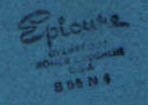|
Epicure was a line of solid colored dinnerware designed by Don Shrekengost.
In 1952 most of the Cavalier shapes were created. With production concentrated on Rhythm, Charm House, Skytone, Debutante, and the new Cavalier line, there was no need to design a new shape for 1953. However, some of the pieces modeled at the end of 1953 are the earliest Epicure pieces. From October to December they include: saucer - dropped edge, dinner plate, cup, handle, sugar with lid, and a bowl. There is a small sketch in the log beside the cup and a note the shape was, "released for production Nov. 17, 1954."
One interesting to note regarding HLC's modeling records is the name Epicure is used in reference to Harlequin:
May 23, 1955 Harlequin Handle for Epicure Cup
June 3, 1955 Larger Harlequin Handle for Epicure Cup
These specially made cups are commonly called Harlequin large cups by collectors. The corresponding 6 7/8" saucers were picked up from generic jumbo cups that had been in production for several years.
It should be noted the standard cup used for Epicure is a coffee cup. There were no teacups in the original assortment, but on October 14, 1955, there is an entry in the log for: Cup, Epicure Dinnerware Size. While none have been accounted for in Epicure glazes, the designer, Don Shrekengost, maintained the tea cups were put into production in the article, Epicure by Matthew Whalen (The Dish, Vol. 1, No 2., 1998).
There are two pieces that are not found in vintage price lists: the tid bit tray and the nut dish. The trays were made with two plates separated by a white plastic column. To date, only white trays have been found. The nut dishes were promotional pieces given out to buyers at trade shows. Most are found in turquoise. Some can even be found with their original bag and price list.
 Epicure was made in four colored glazes; Snow White, Turquoise Blue, Dawn Pink, and Charcoal Gray. The blue, gray, and pink glazes have the appearance of small filings which gives a textured look. The body is heavier than other HLC lines. According to backstamps, the ware is oven proof. Epicure was made in four colored glazes; Snow White, Turquoise Blue, Dawn Pink, and Charcoal Gray. The blue, gray, and pink glazes have the appearance of small filings which gives a textured look. The body is heavier than other HLC lines. According to backstamps, the ware is oven proof.
|